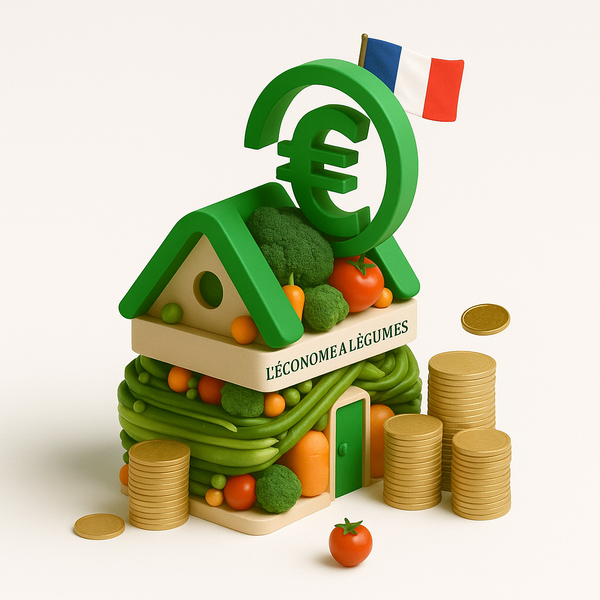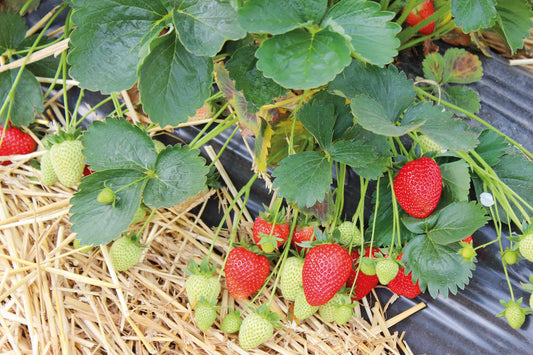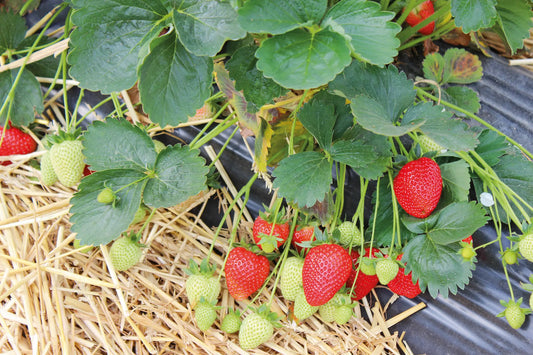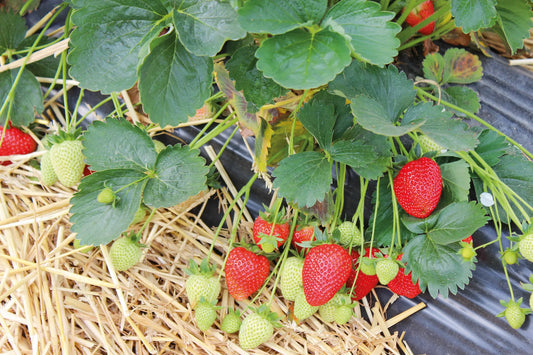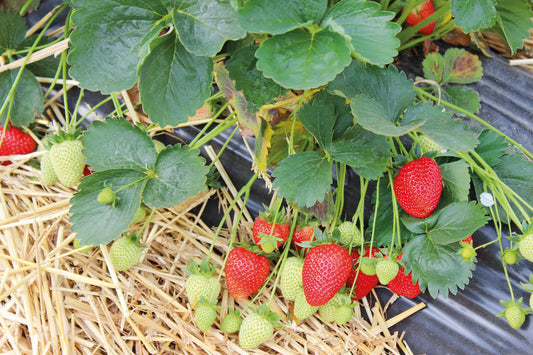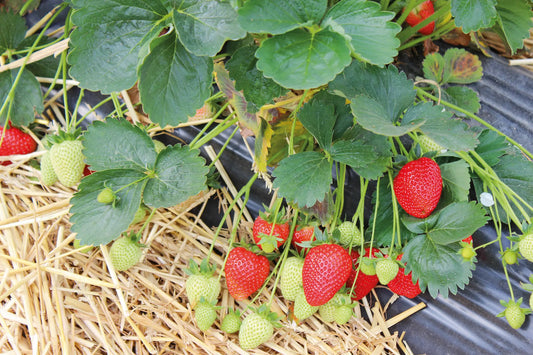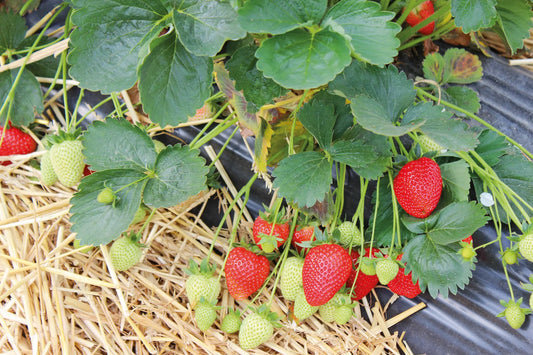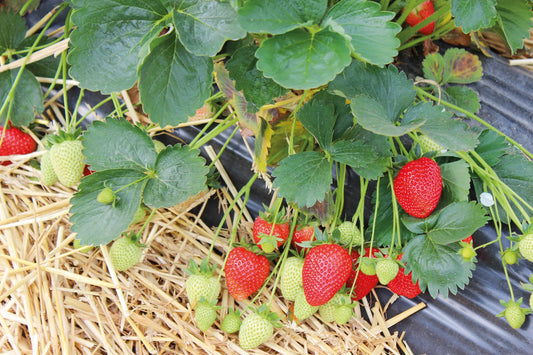Our Hademar Strawberry plants at producer prices
Buy now and get it delivered when you're ready to plant
-
Hademar Frigo A- Strawberry Plant
Regular price €0,30 EURRegular priceUnit price / per -
Hademar Frigo A Strawberry Plant
Regular price €0,31 EURRegular priceUnit price / per -
Hademar Frigo A+ Strawberry Plant
Regular price €0,34 EURRegular priceUnit price / per -
Hademar Potted Strawberry Plant
Regular price €0,36 EURRegular priceUnit price / per -
Hademar Frigo A++ Strawberry Plant
Regular price €0,40 EURRegular priceUnit price / per -
Hademar Mini-Tray Strawberry Plant
Regular price €0,63 EURRegular priceUnit price / per -
Hademar Tray Strawberry Plant
Regular price €0,69 EURRegular priceUnit price / per
Collapsible content
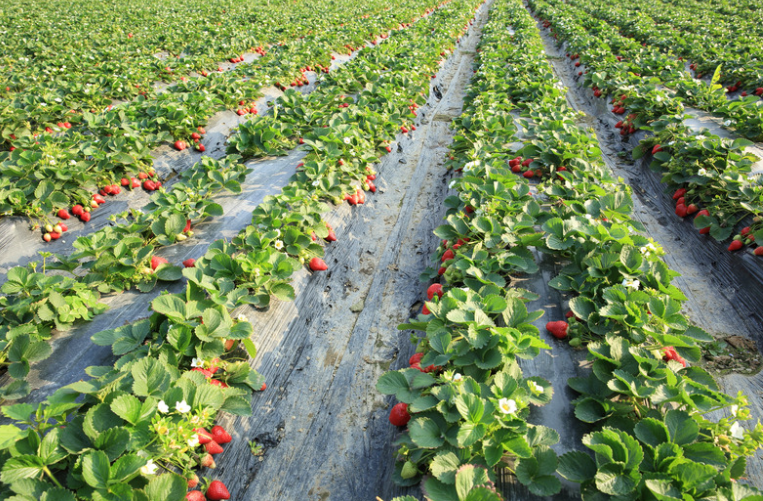
Strawberry Plant Buying Guide: What Type of Plants? For What Market Opportunity?
Which format should you choose: refrigerated, fresh, tray-plants, waiting bed, or plugs? Compare yields, costs, and harvest times at a glance.
Download the PDF guide (13 pages)
Why read this guide?
- Comparison tables: yield (300–600 g/plant), cost & labor.
- Reservation/delivery calendar for each format.
- Minimum order: 20 to 1,000 plants depending on the type.
- Full-field vs. above-ground case studies to maximize margin.
Overview of the 5 professional formats
Detailed comparison of formats
| Format | Yield (g/plant) |
Harvest time | Min. order | Average cost |
|---|---|---|---|---|
| Fridge | 250 – 400 | 120 days | 20 plants | 0.20 – 0.45 € |
| Costs | 280 – 420 | 140 days | 200 plants | 0.20 – 0.45 € |
| Tray plant | 400 – 600 | 90 days | 500 plants | 0.75 – 0.80 € |
| Waiting Bed | 300 – 500 | 105 days | 500 plants | 0.50 – 0.60 € |
| Motte | 230 – 350 | N+1 | 1,000 plants | 0.35 – 0.50 € |
Delivery schedule
| Plant type | Jan | Feb | Mar | Apr | May | Jul | Jul | Aug | Sep | Oct | Nov | Dec |
|---|---|---|---|---|---|---|---|---|---|---|---|---|
| Fridge | ||||||||||||
| Tray plants | ||||||||||||
| Waiting Bed | ||||||||||||
| Motte | ||||||||||||
| Costs |
Which format for which scenario?
Full field controlled budget
Fridge or Fresh : cost 2 x lower than tray plants, planting flexibility.
Above ground in greenhouse
Tray-plants : harvest 90 days after planting, uniform size, reduced labor.
Late planting
Mottes : planting July–August, rapid recovery, harvest the following year.
Ready to plan your plantings?
Download the complete guide Request a quoteFrequently Asked Questions
Is the guide free?
Yes, no fees or obligation to purchase.
How to download it?
Click the button “Download the guide” ; the PDF opens immediately.
Can I request a personalized quote?
Of course: write to us at contact@fraisiverse.com and an agronomist will respond to you within 24 hours.
Choosing the right strawberry varieties for your plot
Extend your harvest season by up to 5.5 months with our "early + season + everbearing" method. Compare 78 cultivars, sizes, and markets.
Download the PDF guide (17 pages)
4 axes to decide quickly
- Harvest Window : Early, Seasonal, or Everbearing? Combine them for 5.5 months .
- Commercial outlet : direct sales, long circuit, processing or freezing.
- Type of plants : fridge, fresh, root ball, tray plants… adapt your investments and your schedule.
- Growing conditions : open field, soilless, greenhouse; target consistent yield and size.
Axis 1: Select your harvest window
Example of recommended mix:
- Ciflorette (early) → Rubis des Jardins (season) → Charlotte (remontant).
- 5.5 months of continuous production, ideal for direct sales.
Axis 2: Sell at the right market
Direct sales
Ciflorette, Charlotte, Mara des Bois: premium taste sought after by consumers.
Long circuit / GMS
Magnum, Clery, Dream: uniform size, 95% class 1 fruit.
Transformation
Darselect, Mara des Bois – high sugar content and stable aroma.
Freezing
Honeoye, Belrubi – firm flesh, keeps well in the cold.
Axis 3: Choose the right type of plants
| Kind | Reservation | Delivery | Highlights |
|---|---|---|---|
| Fridge | All year round | Dec. → Aug. | Flexibility & price |
| Tray plants | Feb. → June | Nov. → Apr. | Above ground, harvest 90 days after planting |
| Motte | Sep. → May | Jul. → Sep. | Ideal for open fields, harvest N+1 |
| Costs | Feb. → Aug. | Sep. → Nov. | Young plants, rapid recovery |
Axis 4: Optimize your technical constraints
Tray plants guarantee +25% yield and simplified harvesting above ground; ideal for mechanizing your production and ensuring consistent size.
Frequently Asked Questions
Is the guide really free?
Yes, with no cost or obligation to purchase.
How to download it?
Just click the button “Download the guide” at the top of the page; the PDF opens immediately.
Can I request a personalized quote?
Of course: contact us via our contact page .
When to plant? When to harvest?
Do you want to start a strawberry farm but don't know when to reserve your plants, when to plant them or even harvest them?
Because we love 🍓 (with just a little sugar), we're going to do the work for you. On this page, you'll find the growing steps for each type of strawberry plant. When to order? What is the delivery period? When to plant? And finally, when to harvest?
Production Calendar - Frigo Strawberry Plants
| Production Calendar - Frigo Strawberry Plants | ||||||||||||||||||||||||
|---|---|---|---|---|---|---|---|---|---|---|---|---|---|---|---|---|---|---|---|---|---|---|---|---|
| Jan | Feb | Mar | Apr | May | Jun | Jul | Aug | Sep | Oct | Nov | Dec | |||||||||||||
| Reservation | ||||||||||||||||||||||||
| Deliverable | ||||||||||||||||||||||||
| Recommended planting | ||||||||||||||||||||||||
| Harvest | ||||||||||||||||||||||||
Production Calendar - Fresh Bare-Root Strawberry Plants
| Production Calendar - Bare Root Strawberry Plants | ||||||||||||||||||||||||
|---|---|---|---|---|---|---|---|---|---|---|---|---|---|---|---|---|---|---|---|---|---|---|---|---|
| Jan | Feb | Mar | Apr | May | Jun | Jul | Aug | Sep | Oct | Nov | Dec | |||||||||||||
| Reservation | ||||||||||||||||||||||||
| Deliverable | ||||||||||||||||||||||||
| Recommended planting | ||||||||||||||||||||||||
| Harvest | ||||||||||||||||||||||||
Production Calendar - Strawberry Plants Plugs
| Production Calendar - Strawberry Plants Motte | ||||||||||||||||||||||||
|---|---|---|---|---|---|---|---|---|---|---|---|---|---|---|---|---|---|---|---|---|---|---|---|---|
| Jan | Feb | Mar | Apr | May | Jun | Jul | Aug | Sep | Oct | Nov | Dec | |||||||||||||
| Reservation | ||||||||||||||||||||||||
| Deliverable | ||||||||||||||||||||||||
| Recommended planting | ||||||||||||||||||||||||
| Harvest | ||||||||||||||||||||||||
Production Calendar - Strawberry Plant Tray
| Production Calendar - Strawberry Plants Motte | ||||||||||||||||||||||||
|---|---|---|---|---|---|---|---|---|---|---|---|---|---|---|---|---|---|---|---|---|---|---|---|---|
| Jan | Feb | Mar | Apr | May | Jun | Jul | Aug | Sep | Oct | Nov | Dec | |||||||||||||
| Reservation | ||||||||||||||||||||||||
| Deliverable | ||||||||||||||||||||||||
| Recommended planting | ||||||||||||||||||||||||
| Harvest | ||||||||||||||||||||||||
Our Growing Guides by Plant Type / Our Growing Tips
Our online advisor: Fraisibot
Our technical itineraries by type of strawberry plant:
Technical Itinerary for Growing Strawberries from Frigo Plants
Technical Itinerary for Growing Strawberries from Plug/Pod Plants
Technical Instructions for Growing Strawberries from Tray or Mini Tray Plants
Technical Guide for Growing Strawberries from Bare-Root Fresh Strawberry Plants
Technical Instructions for Growing Strawberries from Waiting Bed Plants
All our growing tips for planting strawberries:
Strawberry Plants: Soil Preparation and Planting
Soil preparation for strawberry growing, planting techniques, and optimizing strawberry yield.
Best Practices for Irrigation and Fertilization of Strawberry Plants
Efficient irrigation systems, frequency and quantity of watering, types of fertilizers and application times, signs of nutritional deficiencies, growing strawberries in substrate, protection against frost and diseases.
Protection and Prevention of Strawberry Diseases and Pests
The main diseases and pests affecting strawberries, as well as effective methods for their prevention and treatment, including biological control and the use of resistant varieties. It provides practical advice for maintaining healthy and productive strawberry crops.
Succeeding in Strawberry Farming: Costs, Business Strategy and Subsidies
Growing strawberries requires significant initial and ongoing costs, but with effective marketing strategies and sustainable practices, growers can maximize their profits while contributing positively to the environment. Grants and financial aid are available to support necessary investments and encourage environmentally friendly farming practices.
Maximizing Strawberry Harvest and Storage: A Practical Guide
How to determine the optimal time to harvest strawberries, best practices for minimizing fruit damage during picking, and effective methods for storing and managing unsold strawberries to avoid losses and maximize profitability. It offers practical tips for extending the shelf life of strawberries, including refrigeration, freezing, and dehydration.
Strawberry Growing: Why Stagger Production? Early, Seasonal, Late? How to Choose?
Staggering strawberry production allows for harvests to be spread throughout the season, ensuring optimal fruit quality and increased profitability. Learn about recommended varieties for early, mid-season, and late-season production, as well as best practices for harvesting and storage.
-
Delivery from 10 plants to France, Switzerland and Europe
Delivery methodWe deliver anywhere in France as quickly as possible. Cost/quality balance is our priority.
-
Strawberry Plant Wholesale Supplier
About UsWe work with dozens of producers to offer you the best prices.
-
Quality Strawberry Plants
Strawberry Technical ItinerariesOur producers are selected for their reliability and the quality of their products.
-
Collection: Our Hademar Strawberry plants at producer prices
Technical sheet of the Hademar strawberry variety
- Remontant: Remontante
- Earliness: Remontante
- Harvest period: All year round depending on floral induction and planting period by successive period (remontant) and type of plants
- Shape, texture, appearance of the Fruit: Round conical
- Fruit color: Intense and bright red
- Taste characteristics: Sweet and fruity, firm fruit
- Fruit Size: Sweet and fruity, firm fruit
- Disease resistance: Resists root disease and mildew. May warp if photosynthesis is lacking.
- Yield, management and marketing: High percentage of class 1 fruit
- Recommended commercial use / marketing channel: Direct sales, Wholesale
- Our advice: Suitable for both direct and wholesale sales
Order your professional strawberry plants
Fraisiverse, a specialist wholesale supplier of strawberry plants , offers you the Hademar variety, renowned for its strong vigor and premium quality fruits. Buying your strawberry plants guarantees your farm a high yield and varietal resistance appreciated by producers. Our plants come from specialized nurseries, cultivated to offer impeccable professional quality. Benefit from dedicated technical support and personalized advice to optimize your crops. Benefit from our fast and careful delivery throughout France as well as producer prices and decreasing volumes. This everbearing variety ensures you continuous production, ideal for meeting market demands. Order now , reserve now and take advantage of our producer prices to secure your supplies of high-quality Hademar plants.
Varietal characteristics and agronomic qualities
The Hademar strawberry plant stands out as a remontant variety prized by professionals, offering continuous production throughout the season. Its round-conical fruits have a very attractive, intense and bright red color. Their size , a major asset, is generally around 19 to 20 grams in average weight , which positions them favorably on demanding markets. The texture of the Hademar strawberry is particularly appreciated for its firmness , guaranteeing excellent fruit retention and notable resistance after harvest. In terms of taste, it offers a soft and fruity profile, characterized by a sweet dominance and low acidity, a balance that appeals to a wide clientele. Although no precise Brix figure is provided, its taste is described as very aromatic , probably between 8 and 10 ° Brix , which differentiates it from more acidic varieties such as Gariguette or more woody ones such as Mara des Bois. The plant itself is known for its strong vigor , contributing to optimal productivity and general robustness in cultivation.
Technical production itinerary
Planting parameters and density
To fully exploit the potential of the Hademar strawberry in professional production, precise recommendations on the cultivation route are essential. Regarding planting in the open field or under cover, a spacing in the row of 25 to 30 cm between each plant is recommended, while the spacing between the rows should be 60 to 70 cm . These distances make it possible to achieve a planting density of between 47,000 and 66,000 plants per hectare , offering an ideal compromise between yield, accessibility for harvesting and good aeration of the foliage.
Reasoned fertilization and manure plan
The indicative fertilization plan for the Hademar strawberry, a productive, everbearing variety, requires inputs adapted to its high nutrient demand. For nitrogen (N) , a dose of 100 to 130 units per hectare per year is recommended, divided into one third as basal fertilization and two thirds as maintenance, divided into 4 to 5 applications from vegetative recovery to harvest. Phosphorus (P₂O₅) is essential for rooting and must be provided entirely as basal fertilization, at a rate of 70 to 90 units per hectare . Potash (K₂O) , crucial for fruit quality and resistance to water stress, requires 180 to 220 units per hectare , with two thirds as basal fertilization and one third divided during flowering and fruiting. An application of magnesia (MgO) of 30 to 50 units per hectare is also recommended, as a base or for maintenance. Incorporating 30 to 40 tons per hectare of well-composted manure before planting significantly improves soil structure and nutrient availability. Monitoring trace elements such as boron, iron, manganese, zinc, and calcium is also vital, with targeted foliar applications if deficiencies are detected. It is essential to always adjust fertilization according to soil analyses to avoid excesses, particularly nitrogen, which could make the fruit softer.
Operating period and renewal
The optimal productive lifespan of a Hademar strawberry plant is generally 3 years , although it can extend to 4 years under ideal conditions before a significant decline in quality or health occurs. Beyond this period, vigor, fruit size and disease resistance decrease, justifying planned renewal of plots every 3 to 4 years to maintain profitability and production quality.
Productive potential and harvest planning
The Hademar strawberry plant is a very productive variety , capable of offering significant yields of Class 1 fruit. As a repeat-bearing variety, it allows for fruit production in successive waves throughout the season, ensuring a continuous and regular harvest from late spring until the first autumn frosts. Although precise figures per plant or per hectare are not explicitly provided in all sources for Hademar specifically, it is mentioned that its yield can reach several kilos per square meter over the season. For comparison, high-end repeat-bearing varieties can produce between 1.5 and 2.5 kg/m² . For professionals, this ability to provide a continuous supply is a major logistical asset. The high proportion of Class 1 fruit guarantees high commercial value.
Phytosanitary management and integrated protection
Varietal resistances
The Hademar variety is known for its good resistance to diseases , particularly downy mildew and root diseases . This robustness reduces the need for conventional phytosanitary treatments, promoting a more sustainable approach to cultivation. However, regarding resistance to common pests such as thrips, aphids, spider mites, weevils (Anthonomus rubi) or Drosophila suzukii, specific information for Hademar is limited. No source mentions any particular genetic tolerance or resistance to these pests.
Integrated pest management strategies
Thus, for the management of these pests, integrated pest management practices remain essential. This includes the use of biological auxiliaries (ladybugs against aphids, predatory mites against spider mites), the installation of insect netting, regular monitoring of populations and prophylactic methods (cultural hygiene, debris removal). Intervention thresholds are recommended for pests such as thrips (maintain under 4 thrips per flower). It is important to note that pest pressure can vary considerably, with aphid or spider mite infestations affecting up to 100% of plants if no intervention is carried out. Vigilance is therefore essential, even for a robust variety like Hademar.
Economic analysis and varietal positioning
Commercial and logistics opportunities
The Hademar variety is primarily oriented towards fresh consumption , making it a strategic choice for professionals. Its firm texture and good taste make it perfectly suited to direct sales, short circuits, and wholesale markets or large-scale distribution. Its ability to withstand transport and post-harvest storage minimizes losses and facilitates logistics for producers.
Although processing (jam, freezing) is technically possible, it is not Hademar's primary destination. Varieties dedicated to the agro-industry are often selected for other criteria (sugar content, mass yield, etc.). The purchase price of a Hademar mini-tray plant for professionals is approximately €0.63 excluding VAT wholesale, which is a key element in calculating profitability for the strawberry grower.
Varietal comparison and feedback
In the French varietal landscape, Hademar is positioned as an excellent choice among everbearing strawberries. Compared to Charlotte , also everbearing, Hademar has a sweet and fruity taste, whereas Charlotte is appreciated for a "good to very good" taste and more woody or floral aromas. The size of Hademar (19-20g) is similar to that of Charlotte (18-22g), both being superior to Mara des Bois (12-15g), which is distinguished by a very sweet taste and a powerful aroma of wild strawberry, but with a lower yield and size.
Growers recognize Hademar's ability to produce a high proportion of Class 1 fruit , making it profitable and valued for its consistency of production and the quality of its fruit for the fresh market. Its resistance to root diseases and mildew also makes it a less input-intensive variety, which is a significant economic and environmental advantage.
To summarize: Our Hademar strawberry plants
At Fraisiverse , we make it a point of honor to provide professionals with plant material that meets their expectations. As a specialist wholesale supplier of strawberry plants , we offer the Hademar variety, selected for its productivity and the exceptional quality of its fruits. Our plants, from specialized nurseries, guarantee optimal vigor and a high proportion of class 1 fruits. Choosing our offer means buying Hademar strawberry plants and benefiting from professional technical support, controlled logistics and rigorous traceability. Thanks to its natural resistance to mildew and root diseases, this variety reduces input requirements while offering abundant harvests. Whether you are aiming for direct sales, short circuits or large-scale distribution, we assure you a reliable supply. As a recognized specialist wholesale supplier of strawberry plants , we support each customer with personalized advice and a responsive sales service. Our competitive rates and decreasing prices allow you to maximize your profitability. To ensure a successful next season, choose to buy Hademar strawberry plants from our team. Our expertise and high quality standards make us the leading specialist wholesale supplier of strawberry plants for demanding growers.
Fraisiverse - Your supplier of quality strawberry plants. Organic or conventional. Delivery throughout France. Wide range of strawberry plants: Tray Strawberry Plants, Motte Strawberry Plants, Frigo Strawberry Plants, Waiting Bed Strawberry Plants. Strawberry plants for professional and private strawberry growers
